
![]()
CODEINE AND OXYCODONE
Painkillers that can become addictive
![]()
Simon Cotton
University of Birmingham
![]()
Molecule of the Month December 2015
Also available: JSMol version.
![]()
 |
CODEINE AND OXYCODONEPainkillers that can become addictive
Simon Cotton
Molecule of the Month December 2015
|
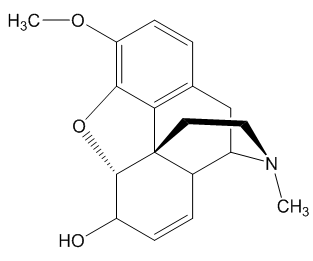 |
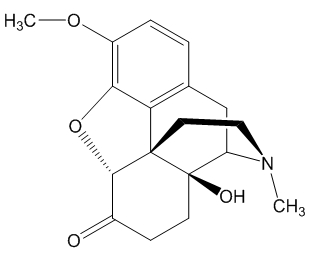 |
Codeine |
Oxycodone |
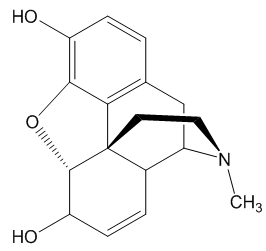 |
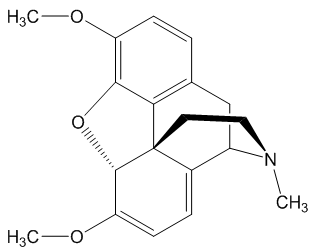 |
Morphine |
Thebaine |
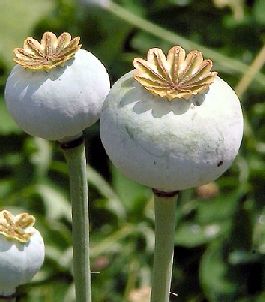 They sound similar, are they related?
They sound similar, are they related?Yes and no. They are both used to treat pain, and share the same molecular backbone (they have similar structures), along with two other important opiates, morphine and thebaine. But there are a number of differences. Oxycodone has only been around for about a century, and is a man-made semisynthetic drug, whilst codeine is a natural substance, from the opium poppy, Papaver somniferum (photo, right). Codeine and morphine are the two natural painkillers made by the opium poppy.
Making a complicated molecule from scratch would require many stages and give a very low overall yield. It’s much more efficient (and time-saving) to get the core structure of the molecule from a natural source, then convert it to the desired molecule in only a few steps. That’s semisynthesis.
It is a long series of reactions, each catalysed by a different enzyme. What follows is a very simplified description. It starts with two molecules of the amino-acid L-tyrosine – one is converted to dopamine, the other one to 2-(4-hydroxyphenyl)acetaldehyde, which are joined together in a condensation reaction, making (S)-norcolaurine. This provides the outline of the skeleton of the molecule.
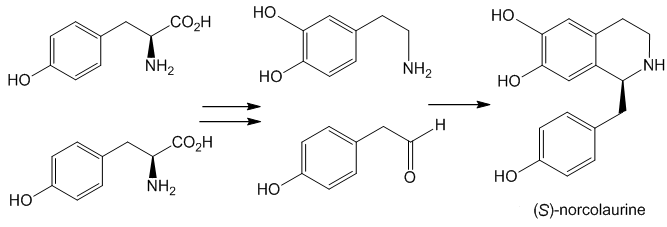
Synthesis of the skeleton of codeine.
Subsequent steps generate additional rings. Norcolaurine is converted into (S)-reticuline, which is then isomerised into (R)-reticuline; this undergoes successive cyclisations (ring-forming reactions) generating first salutaridine and then the alkaloid thebaine.
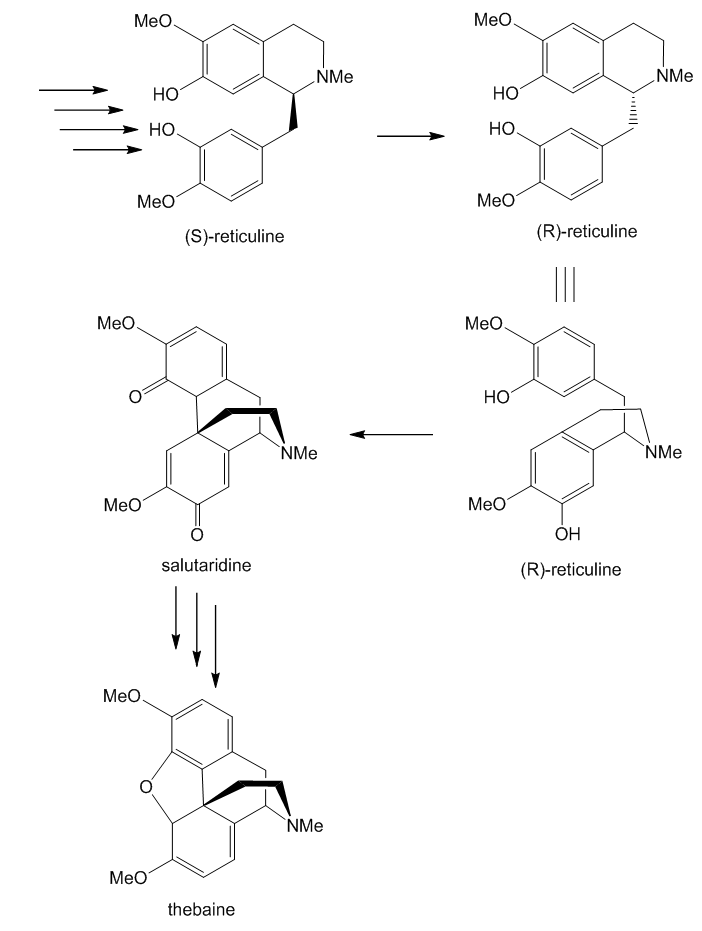
Synthesis of thebaine.
Subsequent steps generate codeine (and morphine).
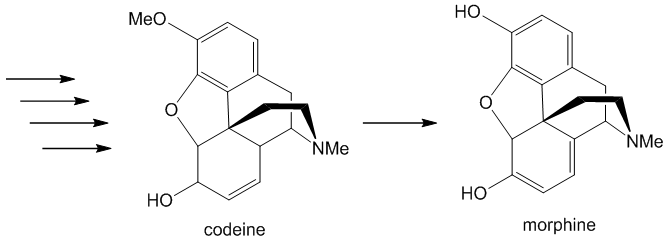
Codeine is present in the opium poppy (Papaver somniferum) at a much lower level than morphine. It can be made from thebaine, another alkaloid which is abundant in the Persian poppy (Papaver bracteatum). Much more codeine is needed for medicines than can be obtained directly from plants, so that most codeine is made from morphine. This is done simply by a methylation of the phenolic –OH group, leaving the –OH group in the other ring unaffected, the method originating with the Russian chemist V. M. Rodionov (1878-1954). Making it from scratch would be too inefficient.
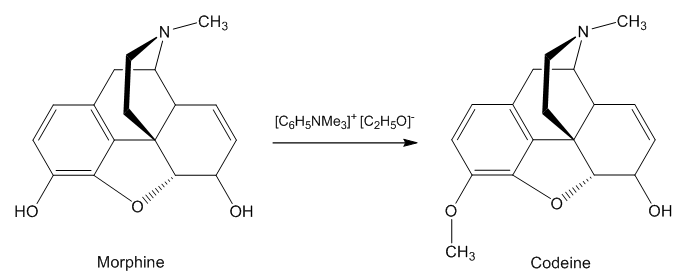
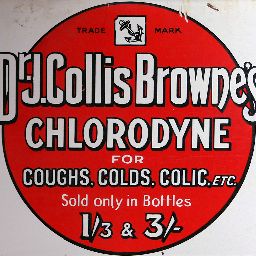 Presumably codeine has been used medicinally for longer than oxycodone?
Presumably codeine has been used medicinally for longer than oxycodone?It has been available in over-the-counter (OTC) medications for many years, usually in combination with other medicinal molecules; mixing it with paracetamol (acetaminophen), aspirin or ibuprofen combines pain-killing and fever-reducing effects. Sometimes caffeine is added as a stimulant. At one time it was a component of Dr J. Collis Browne’s Chlorodyne compound, a very popular OTC medicine; even today, with codeine removed, this remains a widely used treatment of complaints like diarrhoea. Codeine also reduces the urge to cough and is sometimes found in cough syrups.
Oxycodone came about at a time (1917: German (DE) Patent 296916) when pharmaceutical companies were trying to find synthetic painkillers that were superior to morphine (the same impulse earlier led to diacetylmorphine, heroin).
Oxycodone is made from thebaine or codeine (which of course can be made from morphine). Starting from thebaine, the first step is oxidation to 14-hydroxycodeinone; this can be accomplished with a simple oxidant like hydrogen peroxide, but best results are obtained with m-chloroperoxybenzoic acid (m-CPBA) in acetic acid/trifluoroacetic acid. The conjugated C=C bond in 14-hydroxycodeinone can then be subjected to catalytic hydrogenation to give the desired oxycodone.
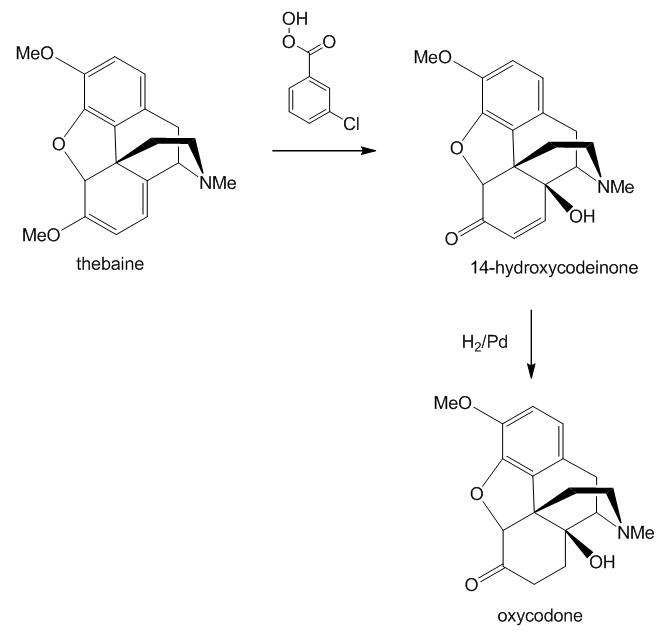
Synthesis of oxycodone.
Codeine is effective in the body as around 10% is converted to morphine, and that is what causes the pain relief. In effect, codeine is a prodrug, a molecule that is converted into the active drug molecule by the body’s own metabolism. Morphine binds to the mu opioid receptors in the central nervous system. How oxycodone works is less certain. Some have suggested mu opioid receptors, others the kappa opioid receptors. Unfortunately, along with the painkilling, oxycodone brings euphoria with it.
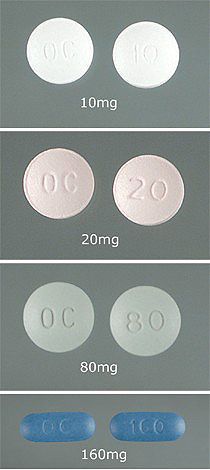 What is the difference between oxycodone and Oxycontin?
What is the difference between oxycodone and Oxycontin?Oxycontin (photo, right) was introduced in 1995 as a controlled-release formulation for oxycodone. This meant that the oxycodone content in the medication was released gradually into the patient, and that they would need to take it every 12 hours or so. Sadly, within a short space of time people found that by crushing it to a powder, all the oxycodone was released at once, defeating the formulation, and they began snorting it or dissolving it in water and injecting it to get a high.
Doctors in the United States began prescribing it widely as a painkiller, not just for the kinds of severe pain, such as terminal stages of cancer, for which morphine is reserved, but for milder situations. People who took it for pain relief liked the feelings that they came to associate with this substance and started on the addictive pathway. Because of its abuse in Appalachian communities, OxyContin has become known as “hillbilly heroin”. Indeed, the US TV series 'Justified' detailed the adventures of a Kentucky US Marshall, Raylan Givens, played by Timothy Olyphant, who spent most of his time trying to solve the problems associated with the locals dealing and smuggling 'oxy'. Surprisingly, heroin iself is actually now a cheaper alternative to Oxycontin, so that many oxy-addicts switch to heroin if Oxycontin is in short supply. As a result, Oxycontin has been blamed as a way into heroin addiction, and both have recently become a serious problem, linked with thousands of deaths in the United States. There is particular concern that use of painkillers amongst adolescents, particularly in treating sporting injuries, is the first step to addiction.
Addiction to painkillers as a whole has become a real problem in the USA, and numerous celebrities have been linked with them, including the late Michael Jackson and the chat show host Rush Limbaugh; Steve Tyler, Courtney Love, Charlie Sheen, Nicole Richie, Winona Ryder, Matthew Perry, Chevy Chase, Kelly Osbourne and Heath Ledger are others, as well as John McCain’s wife Cindy.
 |
 |
 |
 |
Michael Jackson |
Charlie Sheen |
Matthew Perry |
Winona Rider |
Other painkillers are involved too, such as hydrocodone. This has a similar structure – and painkilling properties – to oxycodone. Hydrocodone is found, along with paracetamol (acetaminophen, Tylenol) in the popular medication Vicodin. Another widely used painkiller, Perocet similarly contains oxycodone and paracetamol. Hydrocodone is not to be confused with dihydrocodeine, another painkilling molecule.
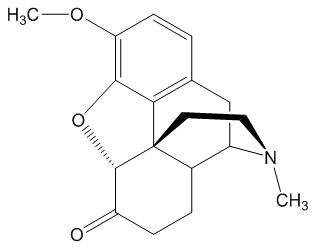 |
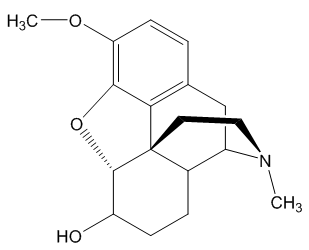 |
Hydrocodone |
Dihydrocodeine |
![]()
![]()
![]() Back to Molecule of the Month page. [DOI:10.6084/m9.figshare.5259832]
Back to Molecule of the Month page. [DOI:10.6084/m9.figshare.5259832]